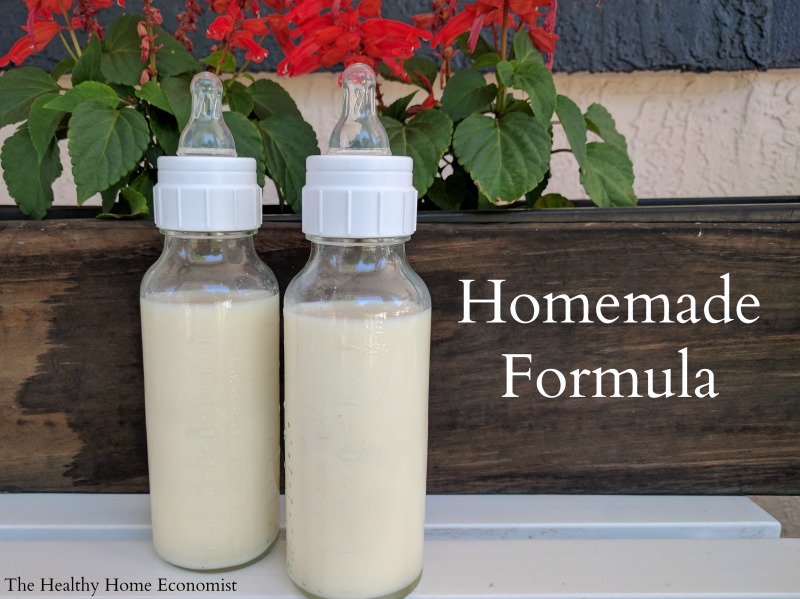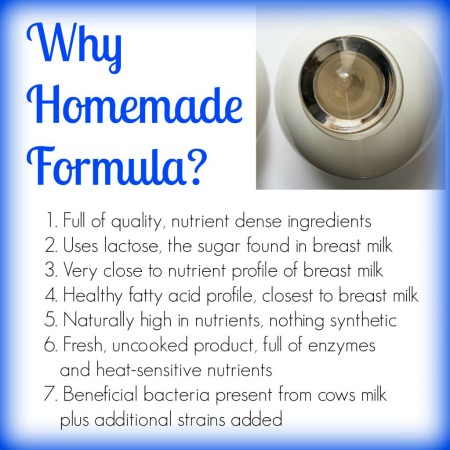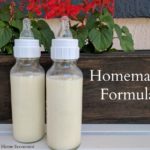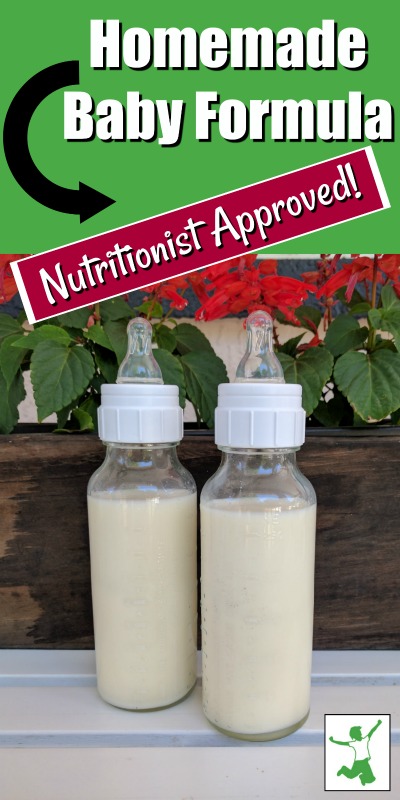Table of Contents[Hide][Show]
A nourishing homemade baby formula using safe, whole ingredients. This recipe was developed and tested by Dr. Mary Enig, a PhD Nutritionist and originally published in Nourishing Traditions cookbook in 1996. It was formulated to match breastmilk as closely as possible and is also suitable for infants. Source: Weston A. Price Foundation

There is no doubt that breastfeeding your baby is the best option for the child’s long-term health and development. Human breastmilk from a well-nourished mother is the perfect food for baby. However, in circumstances where the child is adopted or the Mother finds herself unable to breastfeed, formula feeding becomes necessary. In those cases, homemade baby formula is best.
Using a baby formula recipe that closely matches the nutritional profile of breastmilk is a far better choice than even organic baby formula from the health food store. More on this below.
Note: Donor programs are widely available for human breastmilk. But, the diets of the donor mothers are unknown and most likely nutritionally insufficient. In addition, breastmilk banks pasteurize the donated breastmilk which destroys much of the nutritional benefit. Unless you are fortunate to have a trusted and direct donor milk source in your community, avoid this option!
Dangers of Commercial Formula
Commercial formulas are always a poor choice for a number of reasons. First of all, formula manufacturers line the cans with the chemical BPA. This substance disrupts hormone development and is a probable contributor to early puberty in girls, and ADHD, urogenital abnormalities, and other ills in boys.
The European Food Safety Authority found that canned commercial formula is a significant source of BPA for infants, exposing the child to 13mcg of BPA per kg of body weight per day! BPA-free formula cans are no better. The chemical BPS is typically used instead which is just as dangerous.
Beware that manufacturers pack even organic commercial formula like Earth’s Best in BPA cans. Worse, they use organic brown rice syrup as the primary sweetener which is known to be frequently contaminated with arsenic.
In addition, all commercial milk formulas are processed at extremely high temperatures which violently denature the fragile milk proteins, render them allergenic, and add carcinogens to the final product. Soy infant formula is the worst. Obscenely high processing temperatures not only denature the proteins but large levels of phytic acid in soy block mineral absorption by the infant. Moreover, soy-based plant estrogens disrupt the hormonal development of the baby!
It seems that for the concerned Mother who is unable to breastfeed, learning how to make baby formula at home with safe, pure ingredients is the most prudent way to go!
Why Make Homemade Formula Even if You Are Breastfeeding
In the video below, I show you how to make your own safe, healthy raw milk homemade formula for your baby.
The recipe I follow was originally published in the cookbook Nourishing Traditions in 1996 and developed by Dr. Mary Enig.
Even though I breastfed each of my children for at least 2 years, I made this exact formula for my own children when I was away for the day or the evening as pumping was not an option that worked well for me.
I even used this homemade formula for an entire day once when I had some dental work done and was advised to pump and discard for 24 hours.
As a result, even successfully breastfeeding Moms can use this wonderful homemade formula as a supplement when necessary to their own nutrient-dense breastmilk!
It is advised that even breastfeeding Mothers have the ingredients for this formula on hand for an emergency. If Mom is sick or otherwise unable to nurse, Dad can step in and make this safe alternative until Mom is back on her feet. It takes a few days to a week to gather all the ingredients together to make this formula, which is why I advise having them on hand at all times.
Homemade Most Nutritious
The image below lists the reasons why it is worth it nutritionally to make formula yourself for your precious baby!
You can order all of the required ingredients for the homemade baby formula in one package from this reputable, vetted source.
Moms who have successfully used this formula feeding your children, please post about your experience in the comments section to encourage those who are considering it and need some Mom to Mom encouragement!

Where to Source Quality Milk
The most widely available grass-fed milk around the world is from cows. This is usually the most budget-friendly and easily sourced milk for this recipe for homemade formula.
If only goat milk is available in your area, this recipe for goat milk baby formula can be used instead. When using milk from ewes, please refer to the linked article for an adjusted recipe; one of the benefits of sheep milk is that it is higher in healthy fats than either goat or cow milk.
Camel milk formula is another option that is a particularly digestible form of dairy and growing in popularity around the world.
Alternatively, you can use low temp (vat) pasteurized, non-homogenized whole milk cultured with a piima or kefir starter. Then substitute the piima milk or kefir for the raw milk portion of the formula recipe. Cold-pressed raw milk also must be cultured before using it as it contains no probiotics.
Do NOT use ultrapasteurized (UHT) milk even if organic as it is too highly processed and extremely allergenic!
It is also best to avoid all types of powdered milk for this recipe. The factory process of making milk powder reduces nutrition considerably and denatures it, which makes it more likely baby will have an allergic reaction.
Dairy Allergy Option
If all types of dairy prove unsuitable for your baby, make this nondairy baby formula recipe instead. It uses a base of homemade bone broth as a substitute for milk. It is important not to utilize a plant-based or otherwise vegan baby formula recipe.
Avoid buying bone broth to make the dairy-free formula. Make it yourself! Manufacturers of commercial bone broth, even if authentic, may water down the end product. This is apparent if it does not gel when chilled in the refrigerator.
Many brands have toxic packaging issues as well. If you must buy it in a pinch, see my shopping guide page for vetted brands that are safe.

Homemade Baby Formula Recipe (for infants too)
A nourishing baby formula recipe you can make at home with safe, whole ingredients developed and tested by a PhD nutritionist to match breastmilk as closely as possible. Also suitable for infants.
Ingredients
- 2 cups raw cow milk OR organic whole milk yogurt
- 1 7/8 cups filtered water
- 1/4 cup liquid whey
- 4 Tbl lactose
- 1/4 tsp Bifidobacterium infantis powder
- 2-4 Tbl raw or pasteurized cream
- 1/2 tsp cod liver oil unflavored
- 1/4 tsp butter oil unflavored
- 1 tsp sunflower oil preferably organic
- 1 tsp extra virgin olive oil preferably organic
- 2 tsp virgin coconut oil preferably organic
- 2 tsp nutritional yeast
- 2 tsp gelatin
- 1/4 tsp acerola powder
Instructions
-
Fill a 2 cup Pyrex measuring cup with filtered water and remove 2 TBL (this will give you 1 7/8 cup water).
-
Pour about half the water into a pan and turn burner on medium.
-
Add the gelatin and lactose and let dissolve, stirring occasionally.
-
When gelatin and lactose are dissolved, remove pan from heat and add the rest of the water to cool.
-
Stir in the coconut oil and butter oil until melted.
-
Put remaining ingredients in a glass blender.
-
Add the water mixture and blend for about 3 seconds.
-
Place formula in glass baby bottles or a glass jar and refrigerate.
-
Before giving to baby, warm glass bottle in a pan of hot water or a bottle warmer. NEVER microwave baby bottles!
Recipe Video
Recipe Notes
If using raw cow milk from holstein cows, use 4 Tbl of extra cream (otherwise use 2 Tbl extra cream).
If choosing to make this homemade formula with camel milk, be sure to include 4 Tbl extra cream as camel milk is lower in cream than cow milk.
Do not use high oleic sunflower oil. Use only the brand recommended in the ingredients list which is cold pressed, organic, unrefined, and low oleic.
*Do NOT use powdered whey from the store as it is denatured. Avoid whey from making cheese as it will curdle the formula.
*Do not substitute pasteurized or powdered milk as these are heavily processed, denatured and allergenic foods.
*Do NOT use ultrapasteurized (UHT) cream. It is highly allergenic. Raw or pasteurized cream is acceptable.
*Do NOT use fish oil or krill oil instead of high vitamin cod liver oil as they do not contain any Vitamin D and very little to no Vitamin A.
Collagen powder may be substituted for the gelatin in a pinch (more on peptides in baby formula in this article).
If you are wondering where is the iron in homemade baby formula, this article provides an explanation.
If baby experiences constipation using this formula, try adding 1 tsp of molasses to each batch. This should help move things along.
How to Transition to DIY Formula
Once you’ve viewed the video, gathered the ingredients, and made your first batch, how do you feed it to your baby for the first time?
It is important not to switch all at once as this can cause gas, excessive spit-up, or an uncomfortable change in diaper habits such as constipation or overly loose stools.
Start by giving your baby three-quarters of the old formula blended with one-quarter of the homemade. Try this ratio for a day or two and see how your infant responds.
If no digestive upset or major change in diaper habits occurs, increase the amount to a 50-50 blend of old formula to homemade. Observe for another day or two as before.
If no major issues, increase once again to three-quarters homemade formula to one-quarter old formula. If baby does well on this blend for a third time, you are ready to fully transition to the homemade formula.
At any time during the transition, symptoms of intolerance emerge, back up to the previous successful blend ratio and stay there for a day or two before attempting to increase once again.
Homemade Formula FAQ
Weston Price Foundation
Feeding an Adopted Baby
Traveling Tips with Baby Formula Made at Home
Iron in Baby Formula
Collagen Peptides instead of Gelatin for Homemade Formula?










Unfortunately, the research has borne out that a Mom with a poor diet has breastmilk that does not nourish the baby well at all. For example, Moms who eat a diet that includes processed foods have breastmilk that is thin, white (instead of beige to yellow) and low in fat which affects the infant's brain development. I would be very wary of any donated breastmilk even if not pasteurized considering that the vast majority of Western Moms eat poorly even if they claim to eat healthy.
I know that if I were ever unlucky enough to struggle with breastfeeding with a future baby (hopefully not as I've had no trouble with the first two, even tandem nursing and well beyond two years!) I would do this. I actually have *most* of these ingredients on hand now, although I don't need it since my youngest is nearly 14 months. I would feel secure knowing they had raw milk and also smoothies (with raw egg yolks, plain yogurt, etc.) should anything happen. Ugh! I can barely stand to think about anything separating me and my babies. 🙁 But at least there are good options.
Another option, btw, would be if you had a friend willing to pump for you and NOT pasteurize the milk. I have several friends locally who pump and donate milk but would be willing to give it directly to a friend (and have done this) who eat excellent diets. So if I could manage that if necessary I would!
Good afternoon, I have purchased most of the ingredients for this recipe and was wondering why it is raw cows milk we must use as opposed to pasteurised milk?
Is the raw milk safe to give to a 7 month old?
Could you also tell me if we can use sheep’s milk?
The more I look into what milk I should give my 7 month old the more info I read saying they should be over 1 year old.
He is predominantly breastfed but is demanding more and my wife’s milk supply cannot sustain him so he is having more and more formula which we are not comfortable with hence the reason for a home made version.
Many thanks in advance
Hi Megan, yes there are other ways to make the formula without using cow's milk which I will cover next week.
Sarah, I just found your website. My son is allergic to any dairy, whether it comes from cows, goats or, unfortunately, from me. Since I have not been able to find how to make formula without cow’s milk on your website, I was wondering if you would be able to email me with the information.
Thank you
Jennifer
This is great! Now that I know what most of these ingredients are, it doesn't seem like it'd be that hard to make. There are also other formula recipes for babies who don't tolerate cow's milk well, right? I sometimes considered this when I was afraid I'd be low on supply, but we were able to make it through!
Hi Emily, if you use fresh milk, the formula would last about 1 week in the fridge. I would imagine that you would use it up long before that. Freezing is ok, but the cream does tend to get very slightly chunky upon thawing. I do know some women who have frozen/thawed this formula successfully, so feel free to try it – just know that it is not perfectly smooth when thawed.
How long does this formula last in the fridge? Also, can it be made ahead of time, frozen, and thawed or does that destroy the nutrition? Thanks so much!
Great point Tiffany. A wet nurse would be great if one could be located that ate a nutrient dense diet and one that was also affordable. For most women, though, this would not be an option and the homemade formula would need to be pursued as the next best option.
Can I use Camu Camu powder for the vitamin c instead of the now acerola powder? I really dont care for the absorbic acid in the acerola powder since its derived from corn.
The camu camu powder has a different amount of vitamin C per serving, so you would have to adjust for that.
Hi Betty, ask your local healthfood store to order "Natural by Nature" brand of low temp pasteurized, nonhomogenized whole milk in glass bottles. You can make the homemade baby formula using this milk.
thanks for letting us know about low temp non homogenized whole milk! but what about this ingredient?
2 TBL good quality raw or pasteurized cream (use 4 TBL if the milk is from holstein cows). Do NOT use ultrapasteurized cream!
what should we do if we cannot find any? can we skip this?
I would love to be able to make homemade formula for my baby, but I can't find a raw milk source in my area. I can't even find it non-homogenized. My baby had some issues after she was born that required her to spend 25 days in the NICU. I was unable to breastfeed her and tried to build my milk supply by pumping. When I got my baby home, she wouldn't nurse. I continued to pump and bottle feed her the expressed breast milk, but eventually my milk supply ran out. I currently feed my baby store bought formula because I feel like I don't have any other options. I started her on egg yolks from pastured chickens, but I feel guilty feeding her unhealthy formula. Do you have any advice on how to obtain raw milk? I would really appreciate anything you could tell me. Thanks
Betty,
Do not feel bad. Same thing happened to me with my baby born at 32 weeks. I pumped and took milk to NICU for him to feed, I pumped and stored in freezer…when my. Precious baby finally came home he was used to the bottle, would latch but quickly fall asleep or lose interest…. I was exhausted from getting up and attempting to nurse him, heating up expressed milk and feeding him, then putting him to bed then going back to pumping, labeling, storing and cleaning up….. I was exhausted and was losing my mind. I was so happy to be able to buy ingredients and watch this video. I just bought raw milk/cream and my sister will make yogurt and give me the whey…. Don’t lose heart and please don’t feel bad, you have tried your best.
If you have to give your baby formula try finding one without soy.
Where are you located? The farm I get the milk/cream from is three hrs away from where I live, however , they come down my way once a month so I make sure to get enough for the month. You may have something similar close to you or you can order online.
I wish you and your baby well and hope you are able to make homemade formula.
I thank God for Ms Sarah posting this video.
Ok, lol, just noticed the post from Betty was from 2010.
Hi Sarah,
I’ve been making this formula for some time and it has been wonderful for my babies. I was wondering if it’s important for some reason to only use the bifidobacterium infant’s strain of probiotics? Or can I use something that has this and other strains, like Klaire Labs Ther-Biotic for infants? Thanks!
I would stick with the strain recommended.
I'm so glad you posted this, Sarah! This information NEEDS to get out! Another option would be to hire a wet nurse. Its actually becoming more popular (again). You would have to make sure that the nurse was eating a nourishing diet, but this would be the second best option, if the mother was not able to breast feed her baby. This would be a very expensive alternative though.